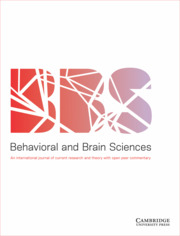Crossref Citations
This article has been cited by the following publications. This list is generated based on data provided by
Crossref.
Kuiper, Koenraad
Bimesl, Neda
Kempen, Gerard
and
Ogino, Masayoshi
2017.
Initial vs. non-initial placement of agent constructions in spoken clauses: A corpus-based study of language production under time pressure.
Language Sciences,
Vol. 64,
Issue. ,
p.
16.
Ambridge, Ben
2018.
Against Stored Abstractions: A Radical Exemplar Model of Language Acquisition.
SSRN Electronic Journal,
Rees, Alice
and
Bott, Lewis
2018.
The role of alternative salience in the derivation of scalar implicatures.
Cognition,
Vol. 176,
Issue. ,
p.
1.
Ziegler, Jayden
Snedeker, Jesse
and
Wittenberg, Eva
2018.
Event Structures Drive Semantic Structural Priming, Not Thematic Roles: Evidence From Idioms and Light Verbs.
Cognitive Science,
Vol. 42,
Issue. 8,
p.
2918.
Garraffa, Maria
Coco, Moreno I
and
Branigan, Holly P
2018.
Impaired implicit learning of syntactic structure in children with developmental language disorder: Evidence from syntactic priming.
Autism & Developmental Language Impairments,
Vol. 3,
Issue. ,
Ziegler, Jayden
and
Snedeker, Jesse
2018.
How broad are thematic roles? Evidence from structural priming.
Cognition,
Vol. 179,
Issue. ,
p.
221.
Wei, Hang
Boland, Julie E.
Brennan, Jonathan
Yuan, Fang
Wang, Min
and
Zhang, Chi
2018.
Lexicalized structural priming in second language online sentence comprehension.
Second Language Research,
Vol. 34,
Issue. 3,
p.
395.
VAN GOMPEL, ROGER P. G.
and
ARAI, MANABU
2018.
Structural priming in bilinguals.
Bilingualism: Language and Cognition,
Vol. 21,
Issue. 3,
p.
448.
Kutasi, Timea
Suffill, Ellise
Gibb, Catriona L.
Sorace, Antonella
Pickering, Martin J.
and
Branigan, Holly P.
2018.
Shared representation of passives across Scottish Gaelic and English: evidence from structural priming.
Journal of Cultural Cognitive Science,
Vol. 2,
Issue. 1-2,
p.
1.
Aryawibawa, I Nyoman
and
Ambridge, Ben
2018.
Is Syntax Semantically Constrained? Evidence From a Grammaticality Judgment Study of Indonesian.
Cognitive Science,
Vol. 42,
Issue. 8,
p.
3135.
Durvasula, Karthik
and
Parrish, Alicia
2019.
Is there phonological feature priming?.
Linguistics Vanguard,
Vol. 5,
Issue. 1,
Stadthagen-González, Hans
Parafita Couto, M Carmen
Párraga, C Alejandro
and
Damian, Markus F
2019.
Testing alternative theoretical accounts of code-switching: Insights from comparative judgments of adjective–noun order.
International Journal of Bilingualism,
Vol. 23,
Issue. 1,
p.
200.
Rees, Alice
Bott, Lewis
and
Schumacher, Petra B.
2019.
Event-related potentials in pragmatic priming.
Neuroscience Letters,
Vol. 712,
Issue. ,
p.
134435.
Favier, Saoradh
Wright, Aileen
Meyer, Antje
and
Huettig, Falk
2019.
Proficiency modulates between- but not within-language structural priming.
Journal of Cultural Cognitive Science,
Vol. 3,
Issue. S1,
p.
105.
Carminati, Maria Nella
van Gompel, Roger P.G.
and
Wakeford, Laura J.
2019.
An investigation into the lexical boost with nonhead nouns.
Journal of Memory and Language,
Vol. 108,
Issue. ,
p.
104031.
Mercan, Gözde
and
Hohenberger, Annette
2019.
Structural priming in the production of Turkish possessive noun phrases and noun clauses.
Journal of Cultural Cognitive Science,
Vol. 3,
Issue. S1,
p.
5.
Halverson, Sandra L.
2019.
‘Default’ translation.
Translation, Cognition & Behavior,
Vol. 2,
Issue. 2,
p.
187.
Ziegler, Jayden
Bencini, Giulia
Goldberg, Adele
and
Snedeker, Jesse
2019.
How abstract is syntax? Evidence from structural priming.
Cognition,
Vol. 193,
Issue. ,
p.
104045.
Rossi, Eleonora
Krass, Kyra
and
Kootstra, Gerrit Jan
2019.
The Handbook of the Neuroscience of Multilingualism.
p.
75.
Ziegler, Jayden
Morato, Rodrigo
and
Snedeker, Jesse
2019.
Priming semantic structure in Brazilian Portuguese.
Journal of Cultural Cognitive Science,
Vol. 3,
Issue. S1,
p.
25.




Target article
An experimental approach to linguistic representation
Related commentaries (30)
A usage-based cognitive linguistic (re-)interpretation of priming evidence
Acceptability judgments still matter: Deafness and documentation
Action sequences instead of representational levels
Can structural priming answer the important questions about language?
Considering experimental and observational evidence of priming together, syntax doesn't look so autonomous
Converging on a theory of language through multiple methods
Developmental psycholinguistics teaches us that we need multi-method, not single-method, approaches to the study of linguistic representation
Don't forget the neurobiology: An experimental approach to linguistic representation
Don't shoot the giant whose shoulders we are standing on
Horses for courses: When acceptability judgments are more suitable than structural priming (and vice versa)
If priming is graded rather than all-or-none, can reactivating abstract structures be the underlying mechanism?
Microscopic and macroscopic approaches to the mental representations of second languages
Moving beyond the priming of single-language sentences: A proposal for a comprehensive model to account for linguistic representation in bilinguals
On the nature of structure in structural priming
Priming is swell, but it's far from simple
Priming methods in semantics and pragmatics
Setting the empirical record straight: Acceptability judgments appear to be reliable, robust, and replicable
Structural priming can inform syntactic analyses of partially grammaticalized constructions
Structural priming is a useful but imperfect technique for studying all linguistic representations, including those of pragmatics
Structural priming is most useful when the conclusions are statistically robust
Structural priming is not a Royal Road to representations
Structural priming supports grammatical networks
Structural priming, action planning, and grammar
Syntactic levels, lexicalism, and ellipsis: The jury is still out
The limitations of structural priming are not the limits of linguistic theory
The logic of syntactic priming and acceptability judgments
The malleability of linguistic representations poses a challenge to the priming-based experimental approach
The relationship between priming and linguistic representations is mediated by processing constraints
The syntax of priming
What structural priming can and cannot reveal
Author response
Structural priming and the representation of language